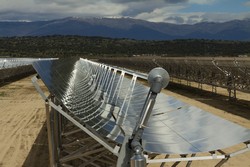High-temperature thermal energy storage
Among the renewable energy technologies, an evident advantage of concentrating solar power (CSP) is the possibility to use relatively cheap thermal energy storage (TES) systems to accumulate thermal energy. The most popular option is to use the sensible heat of a molten salt that is heated at the required temperatures by solar radiation. The EU-funded project OPTS (Optimization of a thermal energy storage system with integrated steam generator) was aimed to develop an innovative TES system for the next generation of CSP plants. It was based on a single-tank configuration, to provide an efficient and innovative energy storage. The experimental and modelling results demonstrated the feasibility to use the stratification (thermocline) of molten salts for both heat transfer and storage purposes. At the same time, an integrated steam generator was designed for large-scale CSP plants. To this end, the innovative concept should have been verified in a relevant scale, but, due to the withdrawal of an industrial partner, it was not possible to finalize this activity. Anyway, modelling results, experimental data and preliminary components cost analysis all suggest that the new technology proposed by OPTS is effective and competitive with regard to CSP storage systems. In particular, the use of the same molten salt mixture for heat transfer and storage eliminates the need for expensive heat exchangers between different process fluids. Moreover, the heat transfer medium can be kept at higher temperatures than oils, resulting in a reduction of the TES system cost. Salt mixture stratification is obtained and maintained thanks to the relative low value of their thermal conductivity. In fact, the salts behave like a thermal insulator preventing heat conduction from layer to layer. The OPTS team investigated thermophysical, material compatibility and heat transport properties of the employed molten salts. Their research included modelling of hot/cold transition zone and heat exchange behaviour as well as the TES impact on CSP plant and the design of a test section plant. Successful demonstration of the technology scalability (up to a 12.5 MWth system) will contribute to its integration in existing CSP plants and achieving the ambitious objectives of the European Industrial Initiative on solar energy.







